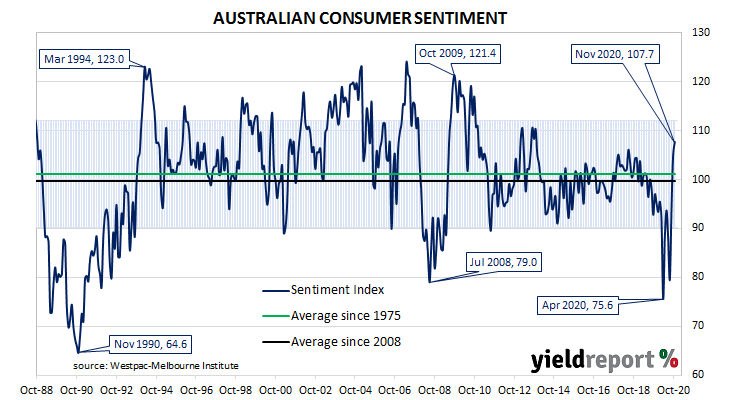Summary: Household sentiment improves for third consecutive month; confidence index comfortably above long-term average; “another strong result; highest since November 2013; index surges in Victoria; all but one components higher; unemployment index higher, respondents expect higher jobless rate
After a lengthy divergence between measures of consumer sentiment and business confidence in Australia which began in 2014, confidence readings of the two sectors converged again around July 2018. Both readings then deteriorated gradually in trend terms, with consumer confidence leading the way. Household sentiment fell off a cliff in April but, after a few months of to-ing and fro-ing, then staged a considerable recovery.
According to the latest Westpac-Melbourne Institute survey conducted in early November, household sentiment has improved to a reasonably optimistic level. The Consumer Sentiment Index rose for a third consecutive month, from October’s reading of 105.0 to 107.7.
“This is another strong result,” said Westpac chief economist Bill Evans.

Local Treasury bond yields rose noticeably at the long end, outrunning overnight increases of US Treasury yields. By the end of the day, the 3-year ACGB yield had crept up 1bps to 0.19%, the 10-year yield had increased by 8bps to 1.00% while 20-year yields finished 6bps higher at 1.63%.
In the cash futures market, expectations of a change in the actual cash rate, currently at 0.04%, did not change materially. At the end of the day, contract prices implied the cash rate would trade in a range between 0.03% and 0.04% through to the end of 2021.
Any reading below 100 indicates the number of consumers who are pessimistic is greater than the number of consumers who are optimistic. The latest figure is the highest since November 2013, substantially above the long-term average reading of just over 101.
Evans noted Victoria was the “standout” in terms of higher confidence levels. However, confidence partially retreated in New South Wales following a surge there in October’s survey.
All sub-indices were higher than a month ago with the exception of the “family finances versus a year ago” sub-index. Also, the Index of Unemployment Expectations increased, indicating “more respondents expect the unemployment rate to rise.”

